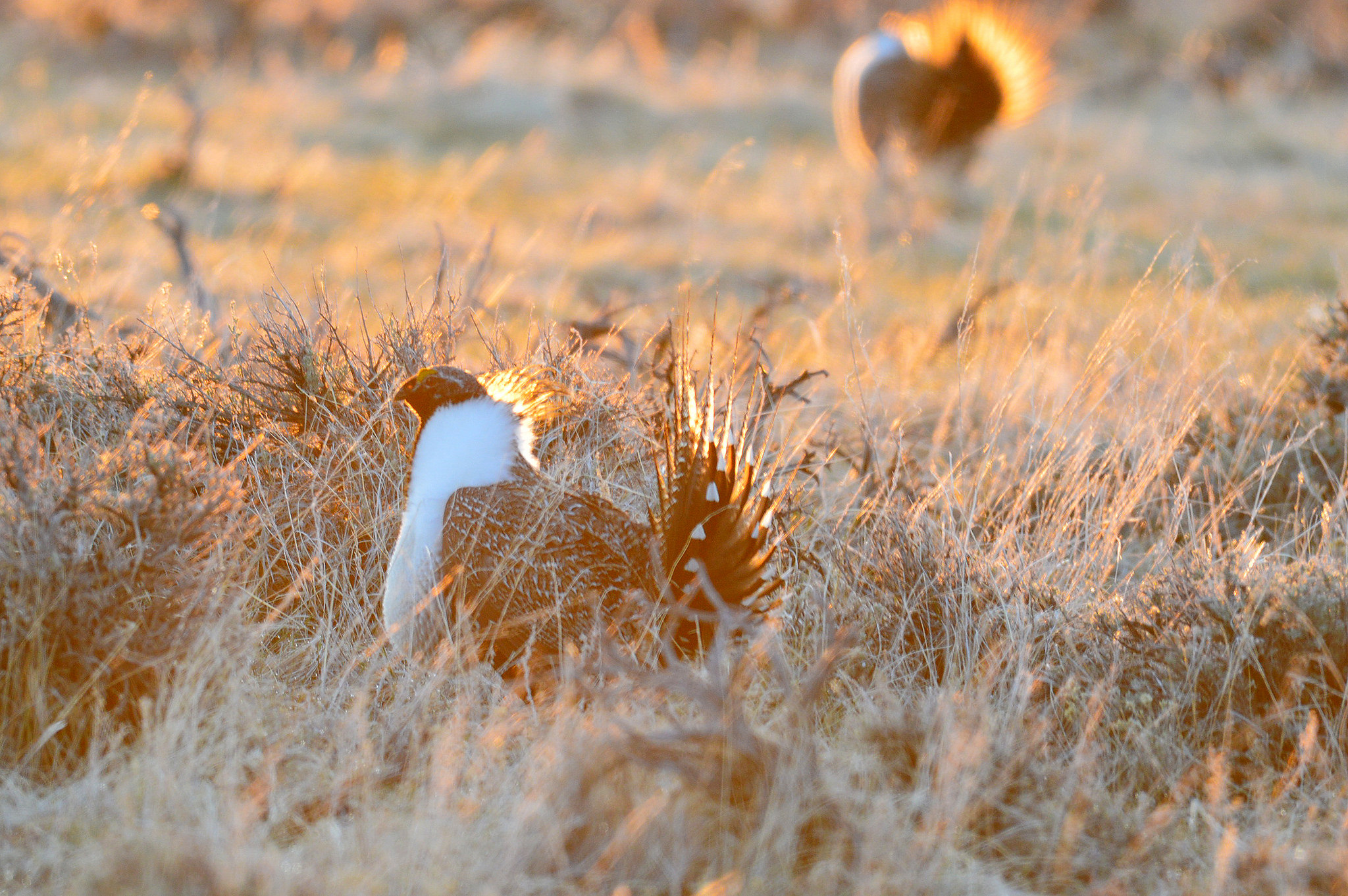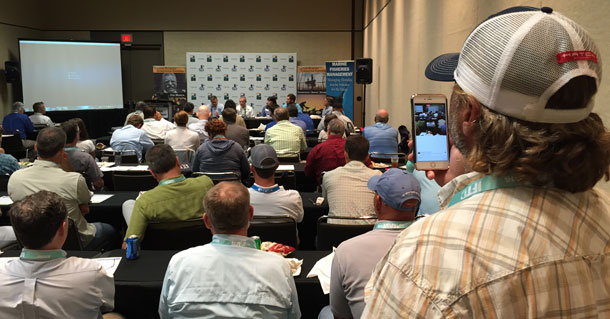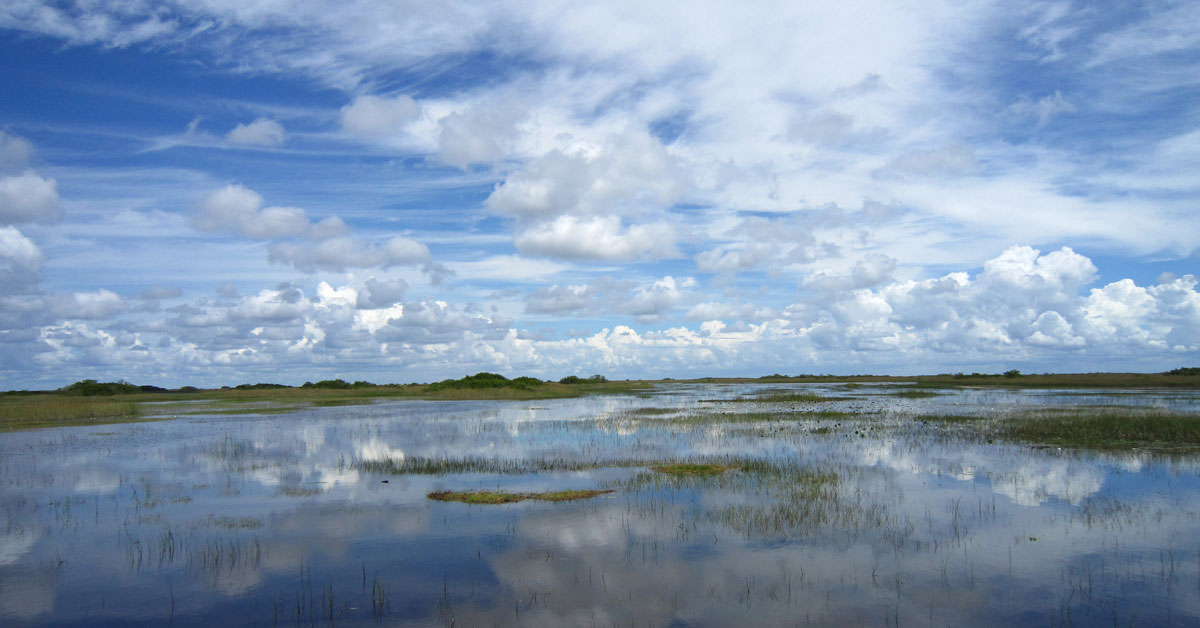On the anniversary of the historic decision not to list the greater sage grouse for endangered species protection, population numbers are up—but there’s still plenty of work to do
Shortly after first light on opening day, my Labs and I maneuvered through the sagebrush in northwest Colorado searching for sage grouse. As we approached a fenced-off meadow, I noticed there were tags on the wires, markers designed to deter grouse from flying into the fence, which many ranchers and others are using to reduce accidental deaths. There definitely had to be birds in the area.
No sooner had I rested my gun on a wooden post to cross the fence when the sagebrush in front of me exploded with the unmistakable sound of a covey flush, and ten sage grouse flew off safely into the sagebrush sea.
Just four years earlier, I’d been hiking what felt like forever in one of my favorite Wyoming honey holes and no birds were to be found. I’d sat on a hillside wondering, “How did we get to this point?” How could a gamebird once so common, widely distributed, and liberally harvested have become so scarce?
That was in the fall of 2012, when drought continued to plague the West. Grouse numbers were low just about everywhere. In fact, the following spring yielded the second-lowest number of male sage grouse attending their breeding grounds in nearly 50 years. But it was more than just drought affecting sage grouse. More than half of the species range had been lost to development, cropland conversion, fire, or invasive juniper trees that the birds generally don’t like. The threats to habitat were so great and bird numbers so low that the U.S. Fish and Wildlife Service was considering whether to protect sage grouse under the Endangered Species Act.
Almost exactly one year ago, the agency decided that the bird was not warranted for listing, and this was heralded as a landmark success for collaborative conservation. On a perfect Saturday morning afield with my dogs, fortunate enough to be hunting sage grouse again, I might agree. But sage grouse are not yet in the clear—here’s why.
The Best Laid Plans
A listing would have dealt a crippling blow to the West and its economy. So, voluntarily, yet with the hammer of the ESA looming overhead, state and federal agencies, private landowners, and numerous stakeholders undertook what will be remembered as perhaps the largest coordinated conservation planning effort in the history of contemporary wildlife management.
Wyoming led the way for the states and dove in head first in 2008, launching its own version of a conservation strategy. Today, all states within the bird’s habitat have some version of a conservation plan for sage grouse. The Natural Resources Conservation Service (NRCS) recognized early on how vital private landowners are to sagebrush conservation and initiated its own strategy, the Sage Grouse Initiative, in 2010. The NRCS immediately began advising and cutting checks to willing landowners to help improve conditions for sage grouse. The Bureau of Land Management and U.S. Forest Service also began their own historic collaboration and developed conservation measures that would amend more than 100 land-use plans to better conserve and manage the sagebrush ecosystem. Finally, the Western Association of Fish and Wildlife Agencies (WAFWA) and the Department of Interior led planning and coordination efforts to combat wildfire and invasive species, like cheatgrass, that threaten sagebrush habitat.
It paid off. On September 22, 2015, the USFWS decided that sage grouse did not require ESA protections. However, that decision was predicated on strong conservation plans, especially on federal public lands, and with assurances that they would be implemented and effective.
Many of the states are implementing their plans. Some like Wyoming have been doing it for several years, but others are barely getting started. Now, one year after finalizing their plans, the BLM just issued guidance to all its field offices on how sage grouse conservation is to be implemented on our public lands.
Hopefully the actual implementation of federal plans doesn’t get as bogged down.

Onward and Upward
So where are we today? Bird numbers are up across most of the range. According to WAFWA, 2015 saw a dramatic increase in males attending their leks—a 63-percent increase over what was recorded in 2013. Many have touted these numbers as evidence that the plans are working, but conditions have been naturally favorable. In 2014, rain finally found its way back to much of sagebrush country, improving habitat and helping to bridge the gap while conservation plans were developed. But there’s no doubt that ongoing conservation efforts are helping too—and it can only get better with more widespread support for the whole suite of conservation plans.
On the private lands front, NRCS has continued to sign on landowners under the Sage Grouse Initiative, with more than 1,200 participating so far. The Initiative has cleared 457,000 acres of encroaching juniper to open up sagebrush habitat, protected more than 400,000 acres from development, improved rangeland and grazing practices that benefit both grouse and livestock on nearly 2.8 million acres, and marked nearly 630 miles of fences to help grouse avoid collisions with deadly wires.
While hunting has never been identified as a major threat to sage grouse, sportsmen sacrificed opportunity in most states either with outright closures or curtailed seasons and smaller bag limits. But we also contributed to the solution with hundreds of millions dollars from hunting licenses, fees, and Pittman-Robertson funding dedicated by the states to sage grouse research and conservation.
Don’t Mess With Success
But not everyone agrees with all of the conservation efforts that are planned or ongoing. The strength of the federal land-use plans has been called into question in no less than six pending lawsuits in which the plans are being called either too onerous or not rigorous enough.
Unfortunately, some in Congress continue to meddle with success by trying to force the federal agencies to use only state-developed plans. The problem is that some state plans cannot stand alone to address the threats to sage grouse, and many are based on voluntary efforts with weak assurances they will be fully implemented. Lawmakers who would rather see state plans adopted across the bird’s range are attaching legislation to the only things moving through Congress—our national defense spending bill and other appropriations bills that keep the government funded.
There should be no language in any future legislation that seeks to delay, defund, or otherwise undo the federal sage grouse conservation plans on millions of acres of America’s public lands, and 105 business leaders agree. These retailers, outfitters, and gear manufacturers, who rely on sportsmen having access to quality fish and wildlife habitat, are urging lawmakers to let sage grouse conservation happen. Read the letter here.
The True Test of Conservation
It’s still far too early to claim victory for sage grouse, and quite honestly, I think we dodged the proverbial bullet. Without rain over the past three years, we may have seen a different scenario play out last fall. The documented increases in bird numbers only reflect a short-term uptick; the long-term trend is still one of gradual decline.
The true test of conservation is yet to come.
If oil prices perhaps break $60 per barrel or if we experience another drought in sagebrush country, then we’ll get to see how well the conservation plans really work. All game bird populations go through cycles, and sage grouse numbers will always fluctuate. But what we do next will determine if the species can emerge from particularly tough times.

The Next Chapter
As for my sage grouse hunt last weekend, the story ends like this: I saw exactly where the covey put down, and soon afterward my dogs and I were on the birds. Once again, I heard the telltale sound of flapping wings, and two shots later we had finished our quest for the iconic bird of the West.
How will the story end for sage grouse across their range? That chapter is still being written.
We must stay on track with implementing the conservation plans—all of them—that were so crucial to the not-warranted decision made one year ago. And we must be wary of political meddling. Congress should ensure that there is adequate funding to implement conservation plans and support the states and private landowners. A new presidential administration will take over soon, and no matter who wins, they too must stay the course for sagebrush conservation.
We have little time to spare, as drought will once again hit the American West, as it always has, and pressures to extract resources from the land will continue to compete with our conservation goals.
Sure, as sportsmen, we want to continue to have opportunities to pursue these birds, trek through brushy landscapes with our dogs, and hear the flush of flapping wings. But, as Americans, we should be proud of a collaborative process that’s working—one that represents our scientists, land managers, private landowners, elected officials, and businesses working together—and see it through to a happy ending for the sagebrush sea.







TO PROPERLY BRING ANY ENDANGERED SPECIES IS TO FARM OR RANCH THE SPECIES IN A CONTROLLED ENVIRONMENT WHERE EXTENSIVE BREEDING CAN BE ACCOMPLISHED AND NURTURING OF THE LIFE OF THE SPECIES, TOBE SAFE FROM ALL PREDATORS, HUNGER AND DISEASES . WHEN POPULATIONS INCREASE TO TWICE THE NEED FOR BREEDING STOCK, THE EXCESS THEN CAN BE REINTRODUCED INTO THEIR MORE COMMON HABITAT. THIS WOULD IN A SHORTER TIME BRING THE SPECIES BACK TO NORMAL POPULATION.
Thanks for your comment Mr. Ingraham. Captive breeding without a doubt played a critical role in saving and moving toward recovery of species like the black-footed ferret and California condor. But sage grouse are a different beast and situation altogether. First, they are not yet endangered and in fact were not listed under the ESA, so captive breeding is not warranted. More importantly, captive breeding in my professional opinion is an absolute last resort when all other efforts have failed. The conservation plans set forth by the federal agencies and states – coupled with voluntary efforts on private lands – should, if implemented, provide the habitat conditions needed to maintain and enhance populations across the range of sage grouse. If we plan carefully and balance multiple uses with conservation, we never should have to resort to captive breeding and release programs in wildlife management. Thanks again for your comment…Ed Arnett, Sr Scientist, TRCP